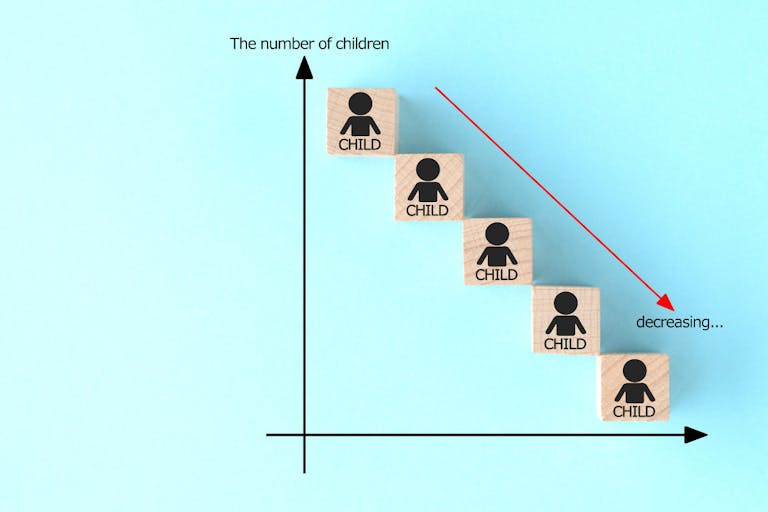
Florida woman charged in 'assisted suicide' death of elderly mother
Bridget Sielicki
·
Superficial solutions not enough to avert demographic disaster in Asian countries
As various Asian countries grapple with serious demographic challenges, governmental responses have failed to address many of the root causes behind women's decisions to postpone childbearing or abort their children and, in error, have opted for more superficial initiatives and incentives.
Many Asian countries have attempted to implement incentives and other strategies to halt the declining birth rate.
These incentives fail to seek to understand and address the root causes for why women in particular are choosing to forego having children at all or are choosing abortion.
More must be done to address root causes and to introduce pro-life, pro-family policies and social structures to reverse the demographic decline.
The writing is on the wall for countries like China, Japan, South Korea, and Singapore, with their abysmal birth rates and aging populations, falling consumption rates, faltering pension systems, long-term threats to economic growth and national security, declining labor forces, and unsustainable pension systems.
Lawmakers have implemented various measures to stimulate childbearing, ranging from cash subsidies for newborns to housing benefits, and have even launched pro-natalist campaigns or limited abortion access in certain instances.
Despite spending billions, birth rates in these affected Asian countries have generally continued to drop.
Many of these Asian countries also lack a Christian heritage that informs pro-life views, and a general lack of pro-life advocacy at the grassroots level has given rise to permissive public attitudes toward abortion.
Many Asian governments have introduced incentives to encourage childbirth and childcare. China provides cash subsidies to families who have their second or third child, has broadened existing maternity and paternity leave policies, and has invested in childcare support.
According to a report by China Briefing:
China has introduced its first-ever national childcare subsidy implementation plan. Announced on July 28, 2025, the policy establishes a unified annual cash subsidy of RMB 3,600 (US$496) per child under the age of three—regardless of birth order—marking a new phase in China’s approach to population and social policy.
This national-level subsidy system represents a strategic pivot in how the government supports families and encourages childbirth amid mounting demographic pressure. It also signals a shift from fragmented local pilot programs to a standardized, centrally coordinated benefit structure. Scheduled to take effect retroactively from January 1, 2025, the policy offers direct financial support to millions of families, while aligning with China’s broader goal of building a more ‘fertility-friendly society.’
Likewise, Japan and South Korea have earmarked massive funds for payouts to new parents, subsidizing education, and offering housing support.
Yet, as current demographic trends reveal, existing policies have yielded little to no long-lasting rise in birth rates. Many people in these countries still remain reluctant or unable to have more children, citing as reasons for their decisions...
high living costs
job insecurity
the responsibilities of childcare
the high cost of housing
A CNN report dated August 2025 quoted a Chinese woman who did not want children, saying, “Knowing that I can’t provide a child with a good environment for education and life, choosing not to have one is also an act of kindness. I definitely don’t want my child to grow up like me … with no chance of upward mobility and struggling at the bottom of society, just as I have.”
A Radio Free Asia (RFA) article from March 7, 2025, reported :
A survey of 18-26 year-olds in October 2021 found that more than 40% of women were either choosing not to marry or unsure whether to marry, compared with just over 19% of men in the same age group. The women surveyed cited lack of time, high financial costs and discrimination against working mothers.
Additionally, limiting abortions after decades of liberal abortion laws (especially in China and parts of Southeast Asia) in efforts to curtail falling birth rates has been generally ineffective in boosting childbirth; these measures tend to view abortion as a standalone issue rather than as evidence of underlying socio-cultural or economic shifts.
Article continues below
Dear Reader,
In 2026, Live Action is heading straight where the battle is fiercest: college campuses.
We have a bold initiative to establish 100 Live Action campus chapters within the next year, and your partnership will make it a success!
Your support today will help train and equip young leaders, bring Live Action’s educational content into academic environments, host on-campus events and debates, and empower students to challenge the pro-abortion status quo with truth and compassion.
Invest in pro-life grassroots outreach and cultural formation with your TRIPLED year-end gift!
Factors like the increasing number of women attending college and entering the workforce, rising living costs, and changing cultural norms around parenthood and family have influenced women's decisions regarding childbirth and abortion.
Though fully protecting the lives of preborn children from abortion is a commendable step in the fight to defend preborn lives, more must be done in addition to address the root causes of why women choose abortion, including:
economic uncertainty
an absence of support
a lack of societal messages supporting parenthood and family
Providing life-affirming alternatives for women and meaningful support to vulnerable pregnant mothers is essential.
On the other hand, in Asian countries like Singapore with few abortion restrictions, the political will to amend existing permissive laws is limited. The Singapore government regards abortion as a private matter, discouraging public debates and leaving pro-life grassroots advocacy efforts to fend for themselves.
Authoritarian governments such as the Chinese Communist Party (CCP) severely restrict civil society and keep close tabs on activists, whereas diverse religious and cultural societies like the Philippines, Singapore, and India hinder the establishment of unified and potent pro-life coalitions, further reinforcing the status quo of permissive and indifferent attitudes towards abortion.
Unlike the situation in many Western countries where pro-life efforts entail well-coordinated campaigns, community networking, public education, as well as robust support networks, many Asian countries lack a visible pro-life presence on the ground.
Such a situation is paradoxical, given the traditional cultural importance many Asian societies give to family, heritage, and lineage. Yet many Asian governments still rely mainly on top-down policies to achieve their natalistic goals instead of exhorting their citizens to establish a culture valuing all human life from conception to death.
The muted pro-life scene in many Asian countries is reflected in the lack of community-based life-affirming programs or educational campaigns to try to discourage abortion. Without potent and well-coordinated pro-life movements, Asian governments face little to no pressure to implement more pro-life, pro-family policies.
With governments that place greater emphases on economic growth and social stability over controversial subjects like abortion, discussions about the sanctity of all human lives are rare. For example, in Singapore, where abortion is legal and accessible on demand until 24 weeks, conversations pertaining to this controversial practice remain low profile, and there is little public opposition to contraception or abortion.
When opportunity permits, proper education and pastoral formation on the sanctity of life (influenced by Christian views on life and death) can go a long way in building a genuine culture of life. Only then can attempts to encourage childbirth and parenthood translate from mere sloganeering to reality.
The measures enacted by several governments in Asia to encourage childbirth and population growth are inadequate, as their demographic crises continue in the face of existing cultural and political hindrances to effective pro-life advocacy, and deeply entrenched socio-economic realities that have yet to be addressed.
Live Action News is pro-life news and commentary from a pro-life perspective.
Contact editor@liveaction.org for questions, corrections, or if you are seeking permission to reprint any Live Action News content.
Guest Articles: To submit a guest article to Live Action News, email editor@liveaction.org with an attached Word document of 800-1000 words. Please also attach any photos relevant to your submission if applicable. If your submission is accepted for publication, you will be notified within three weeks. Guest articles are not compensated (see our Open License Agreement). Thank you for your interest in Live Action News!

Bridget Sielicki
·
Opinion
Angeline Tan
·
Issues
Angeline Tan
·
Guest Column
Emily Berning
·
Opinion
Nancy Flanders
·
Opinion
Mark Wiltz
·
Issues
Angeline Tan
·
International
Angeline Tan
·
International
Angeline Tan
·
Opinion
Angeline Tan
·
Human Interest
Angeline Tan
·